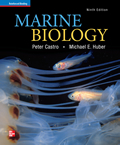
Marine Biology (Castro), 9th EditionChapter 4: Fundamentals of BiologyFor Further ReadingCohen, P., 2003. Renegade code. New Scientist, vol. 179, no. 2410, 30 August, pp. 34–37. Dogma has it that the genetic code has been handed down virtually unchanged to all living organisms, but this genetic operating system may have had some upgrades along the way. Couzin, J., 2002. Breakthrough of the year: Small RNAs make big splash. Science, vol. 298, no. 5602, 20 December, pp.-2296–2297. Long thought to have a relatively mundane role in the biology of cells, RNA turns out to hold big surprises. Foer, J., 2005. Pushing Phylocode. Discover, vol. 26, no. 4, April, pp. 46–51. A controversial group of biologists wants to overturn the system of biological nomenclature that has lasted for centuries. Mattick, J.S., 2004. The hidden genetic code of complex organisms. Scientific American, vol. 291, no. 4, October, pp. 60-67. New evidence suggests that RNA may control genetic information in eukaryotes in previously unsuspected ways. Quammen, D., 2004. Was Darwin wrong? National Geographic, vol. 206, no. 5, November, pp. 2-35. Schmidt, K., 2002, Sugar rush. New Scientist, vol. 176, no. 2366, 26 October, pp. 34-38. Carbohydrate molecules are vastly more varied and important to metabolism than was dreamed of only a few years ago. Villarreal, L. P., 2004. Are viruses alive? Scientific American, vol. 291, no. 6, December, pp. 100-105. There is still no consensus among biologists on the answer to this question. Williams, A., 2005. Challenging Darwin. Bioscience, vol. 55, no. 2, February, pp. 101-105. Wills, C., 2003. The trouble with sex. New Scientist, vol. 180, no. 2424, 6 December, pp. 44-47. Asexual reproduction is less complicated, more efficient, and delivers offspring that are just like the parent, so why do so many species bother with sexual reproduction? We still can t say for sure. Bell S. P. and A. Dutta, 2002. DNA replication in eukaryotic cells. Annual Review of Biochemistry, vol. 71, pp. 333-374. Brommer, J. E., 2000. The evolution of figness in life-history theory. Biological Reviews, vol. 75, pp. 377-404. Costa, D. P. And B. Sinervo, 2004. Field physiology: Physiological insights from animals in nature. Annual Review of Physiology, vol. 66, pp. 209-238. Dahlhoff, E. P., 2004. Biochemical indicators of stress and metabolism: Applications for Marine Ecological Studies. Annual Review of Physiology, vol. 66, pp. 183-207. Kassen, R. and P. B. Rainey, 2004. The ecology and genetics of microbial diversity. Annual Review of Microbiology, vol. 58, pp. 207-231. Storz, G., 2005. An abundance of RNA regulators. Annual Review of Biochemistry, vol. 74. Woese, C. R., 2002. On the evolution of cells. Proceedings of the National Academy of Sciences of the USA, vol. 99, no. 13, pp. 8742-8747. http://www.nature.com/nature/journal/v442/n7106/full/7106xia.htmlhttp://www.nature.com/nature/journal/v440/n7085/full/440747a.html |  |















